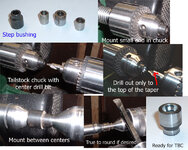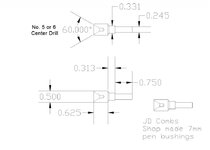Dale Allen
Member
I just did this to show one process of getting this to work.
This is by no means the best way or the only way.
I make my own bushings out of brass so I never use or order the standard bushings anymore. This is one I had around and may have used early on because I started out with a mandrel. The 3-piece set is for a roadster kit and cannot be modified because the tubes are 7mm and the bushings are used for sizing only and do not fit inside the tube. It must be a stepped bushing. Also, this could also be done using pin jaws on a scroll chuck to hold the bushing as I realize not everyone has 2 MT drill chucks.
When you drill out the bushing, the lathe may squeal and complain. Mine did because this is an operation not intended for a wood lathe.
This could also be done on a 'good' drill press, but mine is not!
Finally, I turned the larger section down just enough to take off the black oxide and to determine that the bushing is running true. The small section that fits inside the tube should not be turned down unless it appears to be out of round. I turned this one a little on the end just to check it.
For turning the steel bushing, I use a tool holder and metal cutting carbide bit. I have in the past used HSS tools but it is not recommended and it is dangerous.
It should be noted that these bushings are made to fit only a short way into the tube and get their support from the mandrel. The ones I make and the ones made out of steel for this purpose are about 3 times as long on the part that slides into the tube.
Got questions, I'll try to answer them.
This is by no means the best way or the only way.
I make my own bushings out of brass so I never use or order the standard bushings anymore. This is one I had around and may have used early on because I started out with a mandrel. The 3-piece set is for a roadster kit and cannot be modified because the tubes are 7mm and the bushings are used for sizing only and do not fit inside the tube. It must be a stepped bushing. Also, this could also be done using pin jaws on a scroll chuck to hold the bushing as I realize not everyone has 2 MT drill chucks.
When you drill out the bushing, the lathe may squeal and complain. Mine did because this is an operation not intended for a wood lathe.
This could also be done on a 'good' drill press, but mine is not!
Finally, I turned the larger section down just enough to take off the black oxide and to determine that the bushing is running true. The small section that fits inside the tube should not be turned down unless it appears to be out of round. I turned this one a little on the end just to check it.
For turning the steel bushing, I use a tool holder and metal cutting carbide bit. I have in the past used HSS tools but it is not recommended and it is dangerous.
It should be noted that these bushings are made to fit only a short way into the tube and get their support from the mandrel. The ones I make and the ones made out of steel for this purpose are about 3 times as long on the part that slides into the tube.
Got questions, I'll try to answer them.


